Stephen J. Sniegoski on the
anomalies of September 11 --
part three
September 11 and the origins of the "War on
Terrorism":
A revisionist account
by Stephen J. Sniegoski,
continued.
Table of contents
Reprint rights
Part
three
Big Oil — and Big Policy
Since their motives for war differ, it is necessary to discuss the
actions of Big Oil and Israel separately. (Israel's moves —
and movers — will be examined in the fourth and
concluding part of this article.) President Bush and his top
advisors, most significantly Vice President Dick Cheney, have
had close connections with major oil companies. And major
oil interests have for some time been eyeing the vast, largely
untapped oil and gas resources of the Caspian Basin and
Central Asia.
The Caspian Sea reserves comprise 10 percent of the world's
known supply — worth about $5 trillion at today's prices.
However, Central Asia's oil and gas reserves are landlocked,
which means that the energy wealth must be sent through
long pipelines to reach global markets. Control of
Afghanistan is valuable not because of any oil or gas reserves
of her own but because of her crucial geographic location.
Potential transit routes for oil and natural gas exports from
Central Asia to the Arabian Sea run through Afghanistan.
American oil companies have sought to lay such a pipeline
across that country, but political stability must first be
established in the turbulent region.
The value of Afghanistan, however, far transcends the
oil-pipeline issue. Elie Krakowski, a former Department of
Defense specialist on Afghanistan, points out that
Afghanistan has traditionally been, and remains, a key area in
global power politics:
Why then have so many great nations fought in
and over Afghanistan, and why should we be concerned with
it now? In short, because Afghanistan is the crossroads
between what Halford MacKinder called the world's
Heartland and the Indian subcontinent. It owes its
importance to its location at the confluence of major routes. A
boundary between land power and sea power, it is the
meeting point between opposing forces larger than itself.
Alexander the Great used it as a path to conquest. So did the
Moghuls. An object of competition between the British and
Russian empires in the 19th century, Afghanistan became a
source of controversy between the American and Soviet
superpowers in the 20th. With the collapse of the Soviet
Union, it has become an important potential opening to the
sea for the landlocked new states of Central Asia. The
presence of large oil and gas deposits in that area has
attracted countries and multinational corporations. Russia
and China, not to mention Pakistan and India, are deeply
involved in trying to shape the future of what may be the
world's most unchangeable people. Because Afghanistan is a
major strategic pivot what happens there affects the rest of
the world. [56]
Leftist critics of American imperialism frequently portray
American policy as based simply on the desire for corporate
profits — in the case of 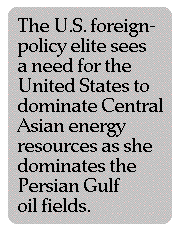 Central Asia, profits from oil. And
their argument contains an element of truth. Most Persian
Gulf countries place stringent restrictions on American
investment, which means that Central Asia is one of the few
remaining growth regions for U.S. oil companies. [57]
Undoubtedly some individuals profit monetarily from those
restrictions; but the policies that American state officials
pursue go far beyond providing mere personal wealth for
themselves or their cronies.
Central Asia, profits from oil. And
their argument contains an element of truth. Most Persian
Gulf countries place stringent restrictions on American
investment, which means that Central Asia is one of the few
remaining growth regions for U.S. oil companies. [57]
Undoubtedly some individuals profit monetarily from those
restrictions; but the policies that American state officials
pursue go far beyond providing mere personal wealth for
themselves or their cronies.
American policies reflect certain
geopolitical beliefs — connected to the economic
interests of particular groups, indeed, but not necessarily
related to the immediate financial gain of particular
policymakers. The United States, or at least her foreign-policy
elite, sees a need for the United States to dominate Central
Asian energy resources as she dominates the Persian Gulf oil
fields. Obviously, the development of those energy resources
will mean financial gain for American investors. But control of
the area will also enhance U.S. global power, and such control
is thus a critical part of a geostrategic strategy to achieve
global hegemony.
U.S. geostrategic models
Among the higher circles, views differ on how best to achieve
the agreed goal of American dominance of Central Asia.
Opinions fall along a continuum between two contrasting
foreign-policy models: competitive and cooperative.
According to the competitive model, other powers are
adversaries in the quest for world power and wealth. It's a
zero-sum game — anything that benefits the United
States's adversaries automatically harms the United States.
America's goal is to achieve world hegemony — any
lesser achievement would leave the United States vulnerable
to her enemies. To achieve hegemony America must act
unilaterally. In particular she must monopolize the world's
crucial energy sources to keep that wealth out of the hands of
potential enemies such as Iran, Russia, and China.
One of the foremost articulators of the competitive position is
Zbigniew Brzezinski, national security advisor in the Carter
administration. In his 1997 work The Grand Chessboard:
American Primacy and its Geostrategic Imperatives,
Brzezinski portrays the Eurasian landmass as the linchpin for
world power, with Central Asia being key to the domination of
Eurasia. [58] For the United States to maintain the
global primacy that Brzezinski equates with American
security, the United States must, at the very least, prevent any
possible adversary, or coalition of adversaries, from
controlling that crucial region. And, of course, the best way for
the United States to prevent adversaries from controlling a
region is to control it herself. [59] With considerable prescience,
Brzezinski remarks that, because of popular resistance to U.S.
military expansionism, his ambitious strategy could not be
implemented "except in the circumstance of a truly massive
and widely perceived direct external threat." [60]
The second model envisions cooperation, rather than
competition, in seizing and managing the resources of
Central Asia. The idea that cooperation with Russia and
China in an expanded world state-capitalism, with its
(notional) concomitant prosperity, would enhance world
peace closely resembles the old Kissinger/Rockefeller 1970s
vision of détente with the Soviet Union. Better transport
and communications links in the Central Asian region could
transform presently 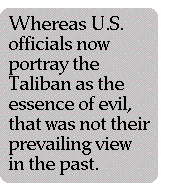 isolated countries into key trading
centers at the crossroads of Europe and Asia —
reminiscent of the Silk Road of the Middle Ages. U.S. officials
predict the 21st Century Silk Road running through Central
Asia will include railroads, oil and gas pipelines, and fiber-optic cables. [61]
isolated countries into key trading
centers at the crossroads of Europe and Asia —
reminiscent of the Silk Road of the Middle Ages. U.S. officials
predict the 21st Century Silk Road running through Central
Asia will include railroads, oil and gas pipelines, and fiber-optic cables. [61]
One twist on the cooperation thesis has it that energy
production in Central Asia, hinging on cooperation between
the United States and Russia, is intended to lessen the
industrial world's dependence on the unstable Middle East.
Making Central Asia safe for state-managed capitalistic
development aimed at enhancing the prosperity of the great
powers entails, of course, the suppression of troublesome
destabilizing elements such as Islamic fundamentalism and
ethnic nationalism. [62]
It appears that actual U.S. policy in
Central Asia leans toward the competitive model, but with
elements of cooperation.
U.S. policy toward Afghanistan
Whereas U.S. officials now portray the Taliban as the essence
of evil, that was not their prevailing view in the past. It
certainly was not their view in the first part of 2001, when the
United States saw the Taliban as a
friendly government, and negotiated with it as such.
Officially the United States condemned the Islamic groups
that used Afghanistan as their base for terrorism, and
officially the United States demanded the extradition of Osama
Bin Laden to face trial in the August 1998 bombing of U.S.
embassies in Kenya and Tanzania. (After the 1998 bombings,
the Clinton regime even launched missile strikes on Bin
Laden's guerrilla camps.) Although the record is convoluted
and murky, it seems that, while the United States wanted to
apprehend Bin Laden, she also sought to improve relations
with the Taliban government, and that the latter goal often
took precedence. Alternatively, one might argue that
although Washington preferred to use negotiation to turn the
Taliban against terrorism and achieve the stability necessary
for regional energy exploitation, she had for some years
considered the military option to remove the Taliban.
U.S.-Taliban relations can be roughly divided into four
periods, though there is much overlap:
• From perhaps two years before the Taliban captured
the capital city of Kabul in 1996 until the embassy bombings
in August 1998 the United States was, at the very least,
covertly friendly toward the Taliban.
• From August 1998 to the beginning of the Bush
administration in January 2001, the U.S. attitude toward the
Taliban cooled, and Washington made plans to eliminate
Osama Bin Ladin; at the same time, however, some covert
cooperation with the Taliban may have continued.
• After the present U.S. regime took power, it attempted
to improve relations with the Taliban but abandoned that
approach in August 2001, owing to a paucity of results, and
made concrete preparations to remove the Taliban
militarily.
• And after the September 11 tragedy, of course,
the U.S. regime implemented the military option to eliminate
the Taliban regime.
American oil companies had cozied up to the Taliban from
the time it took over Kabul in 1996. In 1996, the U.S. oil
company Unocal (Union Oil of California) reached an
agreement with the Taliban to build a pipeline, but the
continuing Afghan civil war prevented that project from
getting started. According to Ahmed Rashid, a Central Asia
specialist and author of Taliban: Militant Islam, Oil, and
Fundamentalism in Central Asia, "Between 1994-96 the
U.S. supported the Taliban politically through its allies Pakistan
and Saudi Arabia, essentially because Washington viewed the Taliban as
anti-Iranian, anti-Shia, and pro-Western." From 1995 to 1997,
Rashid says, "U.S. support was driven by the UNOCAL oil/gas
pipeline project." [63] Private companies conducted the
actual negotiating, but their actions were "encouraged by the
U.S. government." [64]
In May 1997 the New York Times wrote: "The Clinton
Administration has taken the view that a Taliban victory ...
would act as a counterweight to Iran ... and would offer the
possibility of new trade routes that could weaken Russian and
Iranian influence in the region." [65] The Wall
Street Journal opined that Afghanistan could provide "a
prime transshipment route 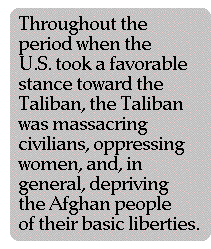 for the export of Central Asia's
vast oil, gas, and other natural resources.
for the export of Central Asia's
vast oil, gas, and other natural resources.
"Like them or not," the Journal continued, "the Taliban are
the players most capable of achieving peace in Afghanistan
at this moment in history." [66]
The U.S. government's main objective in Afghanistan was to
consolidate the position of the Taliban regime, which would
be friendly to the United States, in order to exploit the oil and
gas reserves in Central Asia. Moreover, Washington saw the
Taliban as the enemy of Iran, which had her own proxy in
Afghanistan — the Northern Alliance.
Military support for the Taliban came from Pakistan's
intelligence agency, the ISI (Inter Services Intelligence). In
fact, the Taliban was a virtual creation of Pakistani
intelligence, which viewed Afghanistan as a potential client
state. [67]
The United States, in turn, supported Pakistan as a
counterweight to Iran.
Throughout the period when the United States took a
favorable stance toward the Taliban, the Taliban was massacring civilians, oppressing women, and, in general, depriving the Afghan people of their basic liberties. It was those very same horrors that the United
States, after September 11, 2001, would cite as justification for
her use of military force to overthrow the tyrannical regime
and, presumably, liberate the downtrodden populace.
Amnesty International, which was concerned not with gas and
oil concessions but rather with the Taliban's violations of
human rights, commented negatively about Washington's
apparent friendliness toward that regime. According to
Amnesty International, "Many Afghanistan analysts believe
that the United States has had close political links with the
Taliban militia. They refer to visits by Taliban representatives
to the United States in recent months and several visits by
senior U.S. State Department officials to Kandahar including
one immediately before the Taliban took over Jalalabad." [68]
***
After the 1998 embassy bombings, the Clinton administration
does seem to have moved to a position of opposition to the
Taliban, pushing the UN Security Council to adopt UN
Resolution 1267, which called on the Taliban to hand over
indicted terrorist Osama Bin Laden and to deal with the issue
of terrorism. Economic sanctions were imposed to pressure
the Taliban to comply. The United States also engaged in
some covert operations on Afghanistan's borders and within
the country itself, aimed at ultimately removing the regime.
[69]
But still Washington seems to have mixed its opposition
with covert support. The International Herald Tribune
reported that in the summer of 1998, "the Clinton
administration was talking with the Taliban about potential
pipeline routes to carry oil and natural gas out of
Turkmenistan to the Indian Ocean by crossing Afghanistan
and Pakistan." [70]
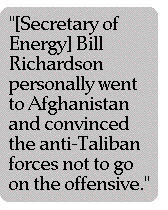 In 1999, Rep. Dan Rohrabacher, a Republican who was a
senior member of the House international relations
committee, with oversight responsibility on policy toward Afghanistan,
complained that "there is and has been a covert policy by this
[Clinton] administration to support the Taliban movement's
control of Afghanistan." Rohrabacher surmised that U.S.
policy was "based on the assumption that the Taliban would
bring stability to Afghanistan and permit the building of oil
pipelines from Central Asia through Afghanistan to Pakistan."
[71]
In 1999, Rep. Dan Rohrabacher, a Republican who was a
senior member of the House international relations
committee, with oversight responsibility on policy toward Afghanistan,
complained that "there is and has been a covert policy by this
[Clinton] administration to support the Taliban movement's
control of Afghanistan." Rohrabacher surmised that U.S.
policy was "based on the assumption that the Taliban would
bring stability to Afghanistan and permit the building of oil
pipelines from Central Asia through Afghanistan to Pakistan."
[71]
In July 2000, Rohrabacher pressed his charge that the United
States was aiding the Taliban in his testimony on global
terrorism before the committee. Rohrabacher said: "We have been supporting the Taliban
because all of our aid goes to the Taliban areas, and when
people from the outside try to put aid into areas not
controlled by the Taliban, they are thwarted by our own State
Department."
He continued: "Let me state for the record [that] at a time
when the Taliban were vulnerable, the top person in this
administration, Mr. [Karl F.] Inderfurth [assistant secretary of
state for South Asian affairs], and [Secretary of Energy] Bill
Richardson personally went to Afghanistan and convinced
the anti-Taliban forces not to go on the offensive.
Furthermore, they convinced all of the anti-Taliban forces
and their supporters to disarm and to cease their flow of
support for the anti-Taliban forces." [72]
U.S. humanitarian aid to Afghanistan did help prop up the Taliban regime. The United States provided
an estimated $113 million in humanitarian aid to
Afghanistan in 2000 and a comparable sum in 2001 prior to
September 11. [73]
***
In 2001, the new Bush administration greatly expanded
American efforts to come to terms with the Taliban on oil
and terrorism. From February to August, the Bush regime
conducted detailed negotiations with Taliban
diplomatic representatives, meeting several times in
Washington, Berlin, and Islamabad. A recent book by French
intelligence analysts Jean-Charles Brisard and Guillaume
Dasquie, Bin Laden: The Forbidden Truth, tells that
story and tells it well. [74]
But the Taliban balked at any pipeline deal and
refused to 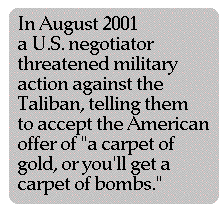 eliminate the terrorist camps in their country.
Instead of serving as a pliable government that could provide
requisite stability for American exploitation of energy
resources, the Taliban were exporting their revolutionary
Islamic fundamentalism to nearby Central Asian countries,
thus destabilizing the entire energy-rich region. According to
Brisard and Dasquie, U.S. negotiations with the Taliban broke
down in August after a U.S. negotiator threatened military
action against the Taliban, telling them to accept the
American offer of "a carpet of gold, or you'll get a carpet of
bombs." [75]
eliminate the terrorist camps in their country.
Instead of serving as a pliable government that could provide
requisite stability for American exploitation of energy
resources, the Taliban were exporting their revolutionary
Islamic fundamentalism to nearby Central Asian countries,
thus destabilizing the entire energy-rich region. According to
Brisard and Dasquie, U.S. negotiations with the Taliban broke
down in August after a U.S. negotiator threatened military
action against the Taliban, telling them to accept the
American offer of "a carpet of gold, or you'll get a carpet of
bombs." [75]
***
Months before August 2001, however, the United States had
been making plans to remove the Taliban. In this connection,
note that it is not unusual for a country to have a multifacted
foreign policy, with contingency plans that vary widely. In
any case, the United States seems to have sought to solve her
differences with the Taliban through negotiations, while at the
same time making plans to remove the regime if negotiations
failed.
Washington had considered projecting its military power into
the Central Asian region for some years. For example, in 1997,
U.S. Special Forces took part in the longest-range airborne
operation in American history, to reach Kazakhstan and
Uzbekistan in order to engage in joint military operations with
military forces from Russia and the former Soviet Central
Asian republics. U.S. News and World Report opined that this
demonstration of America's military muscle was primarily
aimed at "Iran's Islamic-fundamentalist regime. But it also
could be seen as a warning to other potential rivals, including
China and the fundamentalist Taliban militia of Afghanistan."
[76]
After the September 11 attack, it transpired that the United
States and Uzbekistan had been sharing intelligence and
conducting joint covert operations against the Taliban for two
to three years. That prior secret relationship helps explain the
rapid emergence 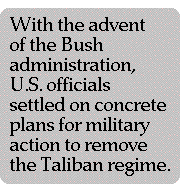 of the post-September 11 military
partnership between the two countries, making Uzbekistan a
base for launching attacks on Afghanistan. [77] Furthermore,
since 1997 special military units of the CIA had been inside
Afghanistan, working with Taliban opposition forces. Not only
did the CIA work with the anti-Taliban Northern Alliance, it
also helped establish an anti-Taliban network in southern
Afghanistan, the area of the Taliban's greatest support. [78]
of the post-September 11 military
partnership between the two countries, making Uzbekistan a
base for launching attacks on Afghanistan. [77] Furthermore,
since 1997 special military units of the CIA had been inside
Afghanistan, working with Taliban opposition forces. Not only
did the CIA work with the anti-Taliban Northern Alliance, it
also helped establish an anti-Taliban network in southern
Afghanistan, the area of the Taliban's greatest support. [78]
With the advent of the Bush administration in 2001, U.S.
officials settled on concrete plans for military action, in
cooperation with other countries, to remove the Taliban
regime. Significantly, some information on those plans leaked
to the public before September 11. On March 15, 2001, the
British-based Jane's International Security reported that the
new U.S. regime was working with India, Iran, and Russia "in a
concerted front against Afghanistan's Taliban regime." India
was supplying the Northern Alliance with military equipment,
advisors, and helicopter technicians, the magazine said, and
both India and Russia were using bases in Tajikistan and
Uzbekistan for their operations.
"Several recent meetings between the newly instituted Indo-U.S. and Indo-Russian joint working groups on terrorism led
to this effort to tactically and logistically counter the Taliban,"
Jane's reported. "Intelligence sources in Delhi said that while
India, Russia, and Iran were leading the anti-Taliban
campaign on the ground, Washington was giving the
Northern Alliance information and logistic support." [79]
According to a June 26, 2001, article in the Indian public-affairs Web magazine Indiareacts.com, the United States,
Russia, Pakistan, and India made a pact for war against the
Taliban. Iran was considered a covert participant. The powers
planned to begin the war in mid October. [80]
A similar story, reported by the BBC on September 18, was
provided by Niaz Naik, a former Pakistani foreign secretary.
He said he was told by senior U.S. officials in mid July that
military action against Afghanistan would go ahead by the
middle of October. The broader goal was the removal of the
Taliban and the installation of a compliant pro-American
regime. According to Naik, he was told that the United States
would launch her operation from bases in Tajikistan, where
American military advisors were already in place. [81]
Four days later, on September 22, The Guardian newspaper
confirmed Naik's account and added that Pakistan had
passed a warning of the impending attack to the Taliban. The
story implied that the warning may have spurred Osama Bin
Laden to launch his attacks, stating that "Bin Laden, far from
launching the attacks on the World Trade Centre in New
York and the Pentagon out of the blue 10 days ago, was
launching a preemptive strike in response to what he saw as
U.S. threats." The warning to Afghanistan came out of a
meeting of senior U.S., Russian, Iranian, and Pakistani
officials at a hotel in Berlin in mid July. [82]
March 18, 2002
To part four (conclusion).
© 2002 by WTM Enterprises. All rights
reserved.
If you found this article to be interesting, please donate to our cause. You should make your check or m.o. payable in U.S. dollars to WTM
Enterprises and send it to:
WTM Enterprises
P.O. Box 224
Roanoke, IN 46783
Thanks for helping to assure a future for TLD!
Notice to visitors who came
straight to this document from off site: You are deep in The Last Ditch. You
should check out our home page and table
of contents.
 Central Asia, profits from oil. And
their argument contains an element of truth. Most Persian
Gulf countries place stringent restrictions on American
investment, which means that Central Asia is one of the few
remaining growth regions for U.S. oil companies. [57]
Undoubtedly some individuals profit monetarily from those
restrictions; but the policies that American state officials
pursue go far beyond providing mere personal wealth for
themselves or their cronies.
Central Asia, profits from oil. And
their argument contains an element of truth. Most Persian
Gulf countries place stringent restrictions on American
investment, which means that Central Asia is one of the few
remaining growth regions for U.S. oil companies. [57]
Undoubtedly some individuals profit monetarily from those
restrictions; but the policies that American state officials
pursue go far beyond providing mere personal wealth for
themselves or their cronies. isolated countries into key trading
centers at the crossroads of Europe and Asia —
reminiscent of the Silk Road of the Middle Ages. U.S. officials
predict the 21st Century Silk Road running through Central
Asia will include railroads, oil and gas pipelines, and fiber-optic cables.
isolated countries into key trading
centers at the crossroads of Europe and Asia —
reminiscent of the Silk Road of the Middle Ages. U.S. officials
predict the 21st Century Silk Road running through Central
Asia will include railroads, oil and gas pipelines, and fiber-optic cables.  for the export of Central Asia's
vast oil, gas, and other natural resources.
for the export of Central Asia's
vast oil, gas, and other natural resources. In 1999, Rep. Dan Rohrabacher, a Republican who was a
senior member of the House international relations
committee, with oversight responsibility on policy toward Afghanistan,
complained that "there is and has been a covert policy by this
[Clinton] administration to support the Taliban movement's
control of Afghanistan." Rohrabacher surmised that U.S.
policy was "based on the assumption that the Taliban would
bring stability to Afghanistan and permit the building of oil
pipelines from Central Asia through Afghanistan to Pakistan."
In 1999, Rep. Dan Rohrabacher, a Republican who was a
senior member of the House international relations
committee, with oversight responsibility on policy toward Afghanistan,
complained that "there is and has been a covert policy by this
[Clinton] administration to support the Taliban movement's
control of Afghanistan." Rohrabacher surmised that U.S.
policy was "based on the assumption that the Taliban would
bring stability to Afghanistan and permit the building of oil
pipelines from Central Asia through Afghanistan to Pakistan."
 eliminate the terrorist camps in their country.
Instead of serving as a pliable government that could provide
requisite stability for American exploitation of energy
resources, the Taliban were exporting their revolutionary
Islamic fundamentalism to nearby Central Asian countries,
thus destabilizing the entire energy-rich region. According to
Brisard and Dasquie, U.S. negotiations with the Taliban broke
down in August after a U.S. negotiator threatened military
action against the Taliban, telling them to accept the
American offer of "a carpet of gold, or you'll get a carpet of
bombs."
eliminate the terrorist camps in their country.
Instead of serving as a pliable government that could provide
requisite stability for American exploitation of energy
resources, the Taliban were exporting their revolutionary
Islamic fundamentalism to nearby Central Asian countries,
thus destabilizing the entire energy-rich region. According to
Brisard and Dasquie, U.S. negotiations with the Taliban broke
down in August after a U.S. negotiator threatened military
action against the Taliban, telling them to accept the
American offer of "a carpet of gold, or you'll get a carpet of
bombs."  of the post-September 11 military
partnership between the two countries, making Uzbekistan a
base for launching attacks on Afghanistan.
of the post-September 11 military
partnership between the two countries, making Uzbekistan a
base for launching attacks on Afghanistan.